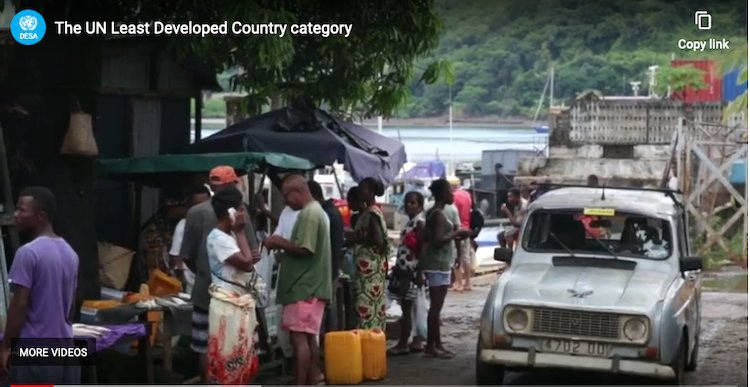
By Jamshed Baruah
GENEVA (IDN) – As the United Nations launches an ambitious global effort to achieve the Sustainable Development Goals (SDGs) by 2030, the fate of the world’s 47 most impoverished nations – the Least Developed Countries (LDCs) – has assumed added importance. UNCTAD, an organization of the UN, is therefore urging them to use external aid to structurally transform their economies. Donors, it adds, should align their support with the national development plans of the poorest nations.
This would tantamount to the international community taking action at the bilateral and multilateral levels to reinforce measures by the LDCs, at the domestic level and to address systemic issues of the international financial architecture that affect their access to development finance. Such actions would include more South-South and triangular cooperation programmes.
The international community should give priority to the adequate representation and voice of LDCs in aid and development finance forums to ensure their specific concerns and interests are taken into consideration, says UNCTAD – the Geneva-based United Nations Conference on Trade and Development. This is especially true when discussing a multilateral debt restructuring mechanism, illicit financial flows, international liquidity or climate finance, it adds.
“This will entail restoring the primacy of multilateralism as the foremost means by which the voice and concerns of LDCs can be heard and catered for,” stresses UNCTAD’s recent landmark Least Developed Countries Report 2019.
LDCs account for 15 of the 20 most aid-dependent countries in the world due to persistent shortfalls in their domestic savings, among other factors.
“For LDCs to attain the Sustainable Development Goals and escape aid dependency, they need external finance that is targeted at the structural transformation of their economies,” UNCTAD Secretary-General Mukhisa Kituyi said.
The report calls for an “Aid Effectiveness Agenda 2.0” to revitalize the aid efficiency agenda consolidated in the 2005 Paris Declaration on the quality of aid and its impact on development. LDCs should be equipped to adjust to a significantly changed aid and development finance landscape.
As the report notes, the developing world has access to a new aid architecture, with a wider array of external finance sources, but this situation has resulted in more complexity and opacity for the LDCs.
Moreover, this funding diversity has not translated into meaningful increases in development finance from all sources. Rather it has expanded the number of actors and instruments.
Watch UN Video on LDCs > https://youtu.be/0hFOIVZD0dM
Official development assistance (ODA) disbursements to LDCs have increased by only 2% annually since the Istanbul Programme of Action of 2011 and remain far from internationally agreed targets, the report observes.
“Critically, the linkages between external development finance and national development priorities are weakening,” said Rolf Traeger, chief of UNCTAD’s LDC section.
The sectoral composition of ODA continues to be biased towards social sectors, which absorb 45% of total aid, compared to economic infrastructure and production sectors, which receive only 14% and 8% respectively.
Modern development finance is also characterized by a growing number of complex instruments and declining concessionality (a measure of the “softness” of a credit reflecting the benefit to the borrower compared to a loan at the market rate).
The net result is that LDCs have increasingly resorted to debt financing, more than doubling their external debt stock from US$146 billion to $313 billion between 2007 and 2017. Currently, one third of LDCs are in debt distress or at high risk of debt distress.
“This threatens debt sustainability and economic development potential. These developments are further weakening the limited state capacities of LDCs,” Mr. Traeger said.
Professor Ugo Panizza, Graduate Institute for International and Development Studies, Geneva said, the Heavily Indebted Poor Countries Initiative and Multilateral Debt Relief Initiative were supposed to put an end to the debt sustainability problems of low-income countries. “Clearly, things did not work as expected, as a substantial number of least developed countries are now classified as being in debt distress or having a high risk of debt distress.”
The recent UNCTAD report, he adds, is “a key instrument for understanding what didn’t work and, more importantly, what should be done to build an aid architecture that can close these countries’ immense financing gaps, without planting the seeds of costly future debt crises”.
European Network on Debt and Development (Eurodad) Director Jean Letitia Saldanha said: “We have long called for developed countries to meet the 0.7 per cent aid target, but also for enhancing the quality of official development assistance, with a view to making it a more effective instrument for fighting inequalities and promoting sustainable development”.
These calls are as relevant as ever at the current juncture, when the multilateral cooperation framework is increasingly under pressure, and aid is subject to growing politicization and to a blurring of the distinction between genuine development cooperation and subsidization of private commercial interests, she added. [IDN-InDepthNews – 14 January 2020]
Photo: Screenshot UN Video ‘Least Developed Countries’. Credit: UN
IDN is flagship agency of the International Press Syndicate.
facebook.com/IDN.GoingDeeper – twitter.com/InDepthNews











